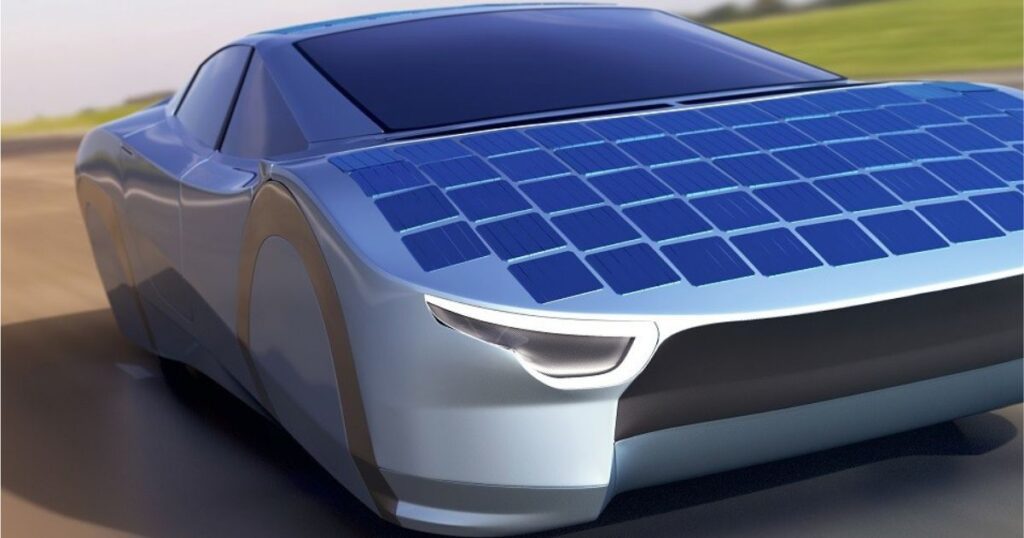Introduction to Solar Cars
Solar cars, powered by photovoltaic cells that convert sunlight into electricity, represent a revolutionary step in automotive technology. As global concerns over climate change and fossil fuel depletion escalate, solar cars offer a promising solution to reduce carbon emissions and dependence on non-renewable energy sources. This article delves into the intricacies of solar car, from their technical specifications to their potential impact on society and the environment.

Technical Specifications Of Solar Cars
Photovoltaic Cells
Photovoltaic (PV) cells are the heart of a solar car’s power system. These cells, usually made from silicon, capture sunlight and convert it into electrical energy. High-efficiency cells are crucial for maximizing the energy harvested from sunlight, especially in regions with variable weather conditions.
Energy Storage Systems
Solar cars are equipped with advanced batteries to store the electricity generated by PV cells. Lithium-ion batteries are commonly used due to their high energy density and efficiency. These batteries ensure that the car can operate even when sunlight is not available, providing a reliable power source during night-time or cloudy days.
Aerodynamic Design
The design of solar car prioritizes aerodynamics to minimize energy loss due to air resistance. Streamlined shapes, lightweight materials, and minimalistic structures help achieve lower drag coefficients, enhancing the car’s overall efficiency and performance.
Electric Motor
The electric motor in a solar car converts electrical energy from the batteries into mechanical energy to drive the wheels. Brushless DC motors are often used for their efficiency and durability. These motors provide a smooth and responsive driving experience, essential for both urban and highway conditions.
Applications
Personal Transportation
Solar car offers a sustainable alternative for personal transportation. As technology advances, solar cars are becoming more accessible to everyday consumers, promising a future where individuals can travel without contributing to carbon emissions.
Public Transport
Incorporating solar technology into public transport systems, such as buses and trams, can significantly reduce the environmental impact of mass transit. Solar panels can be installed on the roofs of these vehicles, supplementing their power needs and reducing reliance on traditional fuels.
Commercial Fleets
Businesses are increasingly adopting solar cars for their commercial fleets. Delivery vans, company cars, and service vehicles powered by solar energy not only reduce operational costs but also enhance the company’s environmental credentials.
Remote Areas
Solar cars are particularly beneficial in remote areas where access to traditional fuels is limited. These vehicles can provide reliable transportation in regions with abundant sunlight but scarce fuel resources, supporting local economies and connectivity.
Benefits
Environmental Impact
Solar car produce zero emissions, drastically reducing the carbon footprint compared to conventional vehicles. By harnessing renewable energy, they help mitigate climate change and improve air quality.
Cost Efficiency
Although the initial investment in solar cars can be high, the long-term savings on fuel and maintenance costs are substantial. Solar energy is free and abundant, making it a cost-effective power source for the lifespan of the vehicle.
Energy Independence
Solar cars contribute to energy independence by reducing reliance on fossil fuels. Countries can lower their energy imports, enhancing energy security and economic stability.
Technological Innovation
The development and adoption of solar cars drive technological innovation in various fields, including renewable energy, materials science, and battery technology. These advancements have broader applications, benefiting other industries and promoting overall technological progress.
Challenges and Limitations
Weather Dependency
Solar cars are dependent on sunlight, which can be inconsistent due to weather conditions. Cloudy days and limited daylight hours in certain regions pose challenges for consistent energy generation.
Energy Efficiency
Current solar technology has limitations in terms of energy conversion efficiency. While advancements are being made, the efficiency of PV cells and energy storage systems needs to improve to make solar cars more viable for everyday use.
Infrastructure
The widespread adoption of solar cars requires supportive infrastructure, such as charging stations and maintenance facilities. Developing this infrastructure is a significant undertaking that requires coordinated efforts from governments, businesses, and communities.
Cost
The high cost of solar car technology, including advanced PV cells and batteries, is a barrier to widespread adoption. Economies of scale and technological advancements are necessary to bring down costs and make solar cars more accessible to the general public.
Latest Innovations
Advanced Photovoltaic Materials
Researchers are developing new materials for PV cells, such as perovskite and organic photovoltaics, which offer higher efficiency and lower production costs. These innovations could revolutionize the solar car industry by making solar panels more effective and affordable.
Solid-State Batteries
Solid-state batteries promise higher energy density and faster charging times compared to traditional lithium-ion batteries. These batteries could significantly enhance the performance and range of solar cars, making them more practical for long-distance travel.
Autonomous Solar Cars
Integrating autonomous driving technology with solar cars can optimize energy use and improve safety. Autonomous solar cars can manage their energy consumption more efficiently, extending their range and reducing the need for human intervention.
Flexible Solar Panels
Flexible solar panels, made from lightweight and durable materials, can be integrated into various surfaces of the car. This innovation allows for more extensive use of the vehicle’s surface area for energy generation, enhancing overall efficiency.
Future Prospects
Mass Adoption
As technology advances and costs decrease, solar cars are likely to become more common on the roads. Mass adoption will be driven by environmental regulations, consumer demand for sustainable solutions, and advancements in solar technology.
Integration with Smart Grids
Solar cars can be integrated with smart grids, allowing them to not only draw power from the grid but also feed excess energy back into it. This bi-directional energy flow can enhance grid stability and efficiency, creating a more resilient energy system.
Expansion into Emerging Markets
Emerging markets with abundant sunlight and growing energy needs are prime candidates for solar car adoption. These regions can leapfrog traditional automotive technologies and embrace solar cars as a sustainable transportation solution.
Policy and Incentives
Government policies and incentives will play an important role in encouraging solar car adoption. Subsidies, tax breaks, and investments in research and infrastructure can accelerate the development and deployment of solar cars.
Comparative Analysis
Solar Cars vs. Electric Cars
While both solar and electric cars are eco-friendly, solar cars have the advantage of generating their own power. Electric cars rely on external charging infrastructure, which often uses non-renewable energy sources. Solar cars, however, face challenges with energy generation efficiency and weather dependency.
Solar Cars vs. Hybrid Cars
Hybrid cars combine internal combustion engines with electric motors, offering improved fuel efficiency and lower emissions. However, they still rely on fossil fuels. Solar cars eliminate the need for fossil fuels entirely, providing a more sustainable solution, albeit with current limitations in energy storage and generation efficiency.
User Guides
How to Drive a Solar Car
Driving a solar car is similar to driving an electric vehicle. Drivers need to monitor battery levels and be mindful of energy consumption, especially during long trips. Utilizing regenerative braking and minimizing air conditioning use can extend the car’s range.
Maintenance Tips
Maintaining a solar car involves regular checks of the PV cells, batteries, and electric motor. Cleaning the solar panels to ensure maximum sunlight absorption and scheduling periodic battery health assessments are crucial for optimal performance.
Conclusion
Solar cars represent a significant step towards sustainable transportation. While challenges remain, technological advancements and supportive policies can drive their adoption and integration into our daily lives. Embracing solar cars can lead to a cleaner, more sustainable future, reducing our carbon footprint and dependence on fossil fuels.
SEO Meta Description: Discover the future of sustainable transportation with solar cars. Learn about their technology, benefits, challenges, and potential impact on the environment.
